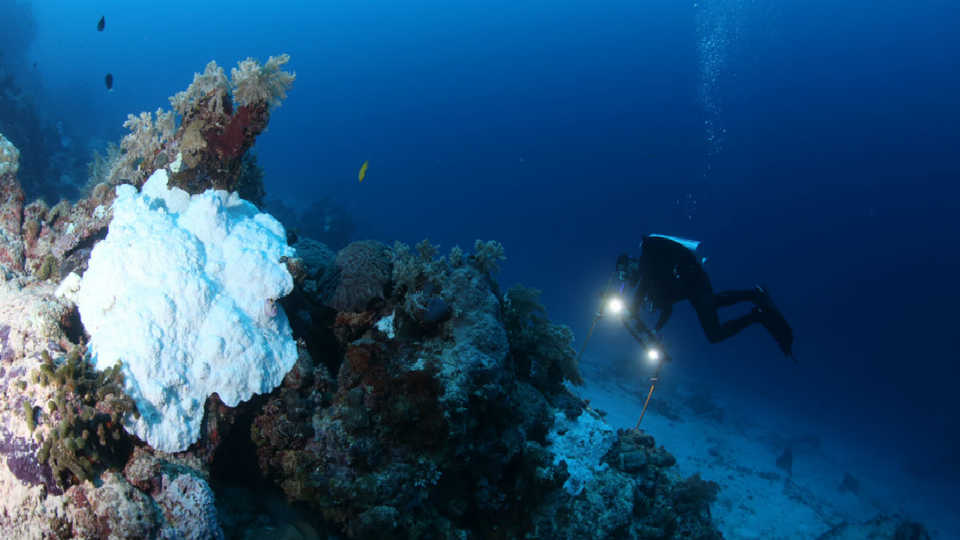A team of researchers, including Dr. Pim Bongaerts from the California Academy of Sciences, takes a closer look at the state of the world’s largest coral reef.

A diver takes a closer look at corals. © Pim Bongaerts
SAN FRANCISCO (September 4, 2018) — A new study demonstrates that the recent mass coral bleaching on the Great Barrier Reef was not restricted to shallow depths, but also affected deep reefs. Although deep reefs are often considered a refuge from thermal anomalies, the new research highlights limitations to this role and argues that both shallow and deep reefs are under threat of mass bleaching events. Published today in the journal Nature Communications, the study focuses on the mass bleaching event in 2016 that caused the death of 30% of shallow-water corals on the Great Barrier Reef. It details how the impacts of this bleaching lessened over depth, but were still substantial on deep reefs.
“During the bleaching event, cold-water upwelling initially provided cooler conditions on the deep reef,” says study co-author Dr. Pim Bongaerts, curator of invertebrate zoology and Hope for Reefs co-leader at the California Academy of Sciences. “However, when this upwelling stopped towards the end of summer, temperatures rose to record-high levels even at depth.”
Lead author Dr. Pedro Frade from the Center of Marine Sciences (CCMAR) says the research team was astounded to find bleached coral colonies down to depths of 131 feet beneath the ocean’s surface. “It was a shock to see that the impacts extended to these dimly lit reefs, as we were hoping their depth may have provided protection from this devastating event.”
The Great Barrier Reef is known to harbor extensive areas of deep coral reefs that are notoriously difficult to study. Using remotely operated vehicles (ROVs), the team deployed sensors to 328 feet beneath the ocean’s surface to characterize how temperature conditions at depth differ from those in shallow habitats.
A team of divers then conducted surveys during the height of bleaching across a number of sites on the northern Great Barrier Reef. They noted that overall, major bleaching and mortality affected almost a quarter of corals at the deep sampling points, while confirming previous reports of impacts on close to half the shallower corals.
“Unfortunately, this research further stresses the vulnerability of the Great Barrier Reef,” says Dr. Ove Hoegh-Guldberg from The University of Queensland, where the study was conducted. "We already established that the refuge role of deep reefs is generally restricted by the limited overlap in species with the shallow reef. However, this adds an extra limitation by demonstrating that the deep reefs themselves are also impacted by higher water temperatures.”
The researchers will continue to study how the process of recovery varies between shallow and deep reefs.
To contact CCMAR:
Rita Costa Abecasis: arabecasis@ualg.pt; +351 289 800 051; +351 917404037
About CCMAR:
Located in the Algarve, South of Portugal, CCMAR (Center of Marine Sciences) is one of the main marine research centers in Portugal, with strategic partners at the University of Algarve and IPMA. For more information, please visit www.ccmar.ualg.pt
The Institute for Biodiversity Science and Sustainability at the California Academy of Sciences is at the forefront of efforts to understand two of the most important topics of our time: the nature and sustainability of life on Earth. Based in San Francisco, the Institute is home to more than 100 world-class scientists, state-of-the-art facilities, and nearly 46 million scientific specimens from around the world. The Institute also leverages the expertise and efforts of more than 100 international Associates and 450 distinguished Fellows. Through expeditions around the globe, investigations in the lab, and analyses of vast biological datasets, the Institute’s scientists work to understand the evolution and interconnectedness of organisms and ecosystems, the threats they face around the world, and the most effective strategies for sustaining them into the future. Through innovative partnerships and public engagement initiatives, they also guide critical sustainability and conservation decisions worldwide, inspire and mentor the next generation of scientists, and foster responsible stewardship of our planet.
Press Contacts
If you are a journalist and would like to receive Academy press releases please contact press@calacademy.org.
Digital Assets
Hi-res and low-res image downloads are available for editorial use. Contact us at press@calacademy.org to request access.